
Rudbeckia hirta, commonly called black-eyed Susan, is a North American flowering plant in the family Asteraceae, native to Eastern and Central North America and naturalized in the Western part of the continent as well as in China. It has now been found in all 10 Canadian Provinces and all 48 of the states in the contiguous United States.

Physalis is a genus of approximately 75 to 90 flowering plants in the nightshade family (Solanaceae), which are native to the Americas and Australasia. At least 46 species are endemic to Mexico. Cultivated and weedy species have been introduced worldwide. A defining feature of Physalis is a large, papery husk derived from the calyx, which partly or fully encloses the fruit. Many species bear edible fruit, and some species are cultivated.

Physalis angulata is an erect herbaceous annual plant belonging to the nightshade family Solanaceae. Its leaves are dark green and roughly oval, often with tooth shapes around the edge. The flowers are five-sided and pale yellow; the yellow-orange fruits are borne inside a balloon-like calyx. It is native to the Americas, but is now widely distributed and naturalized in tropical and subtropical regions worldwide.
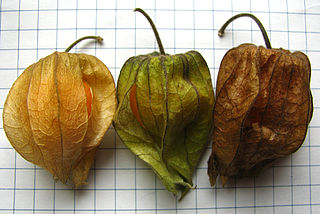
Physalis heterophylla, colloquial name clammy groundcherry, is species of herbaceous plant in the family Solanaceae. It is native to North America, occurring primarily in the eastern United States and Canada. It is known to occur in all contiguous states except for Nevada and California. It is found mainly in habitats such as dry or mesic prairies, gravel hills and rises, sandy or rocky soils, and waste places such as roadsides.

Physalis longifolia, known by the common names common groundcherry, longleaf groundcherry, and wild tomatillo, is a species of flowering plant in the nightshade family, Solanaceae. It is native to North America, where it is native to eastern Canada, much of the continental United States, and northern Mexico. It has also been noted as an introduced species in other regions, including parts of the United States outside its native range. In some areas, such as California, it is an occasional noxious weed.

Physalis acutifolia is a species of flowering plant in the nightshade family known by the common names sharpleaf groundcherry and Wright's ground-cherry. It is native to the southwestern United States from California to Texas, and northern Mexico, where it can be found in many types of habitat, including disturbed areas. It is sometimes a weed when it springs up in agricultural fields, but it is generally not weedy in wild habitat. This is an annual herb producing a branching stem up to a meter tall. The lance-shaped to oval leaves are up to 12 cm long and have edges lined with shallow, smooth teeth. The herbage is coated thinly in hairs appressed flat against the surface. The flowers growing from the leaf axils are round and flat-faced and sometimes over 2 cm wide. They are white to pale yellow with wide, bright yellow centers. The five stamens are each tipped with an anther about 3 mm long. The star-shaped calyx of sepals at the base of the flower enlarges as the fruit develops, becoming an inflated, ribbed lantern-shaped structure about 2 cm long which contains the berry.
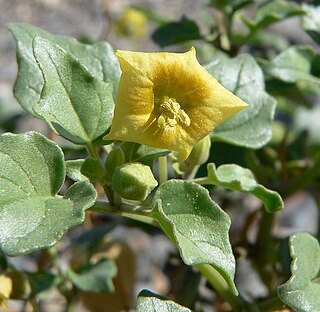
Physalis crassifolia is a species of flowering plant in the nightshade family known by the common names yellow nightshade groundcherry and thick-leaf ground-cherry. It is native to the southwestern United States and northern Mexico, where it can be found in rocky, dry desert and mountain habitat. This is a perennial herb producing a ridged, angular, branching stem approaching 80 cm long, taking a clumped, matted, or erect form. The fleshy oval leaves are 1 to 3 cm long and have smooth, wavy, or bluntly toothed edges. The herbage is glandular and coated in short hairs. The yellow flowers growing from the leaf axils are widely bell-shaped, vaguely five-lobed, and around 2 cm wide. The star-shaped calyx of sepals at the base of the flower enlarges as the fruit develops, becoming an inflated, angled lanternlike structure about 2 cm long, which contains the berry.
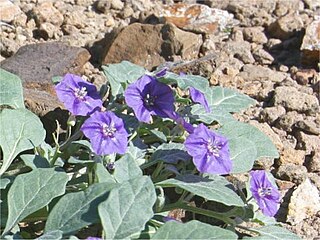
Quincula is a monotypic genus of flowering plants in the nightshade family, Solanaceae. The sole species it contains, Quincula lobata, is commonly known as Chinese lantern, lobed groundcherry, or purple groundcherry.
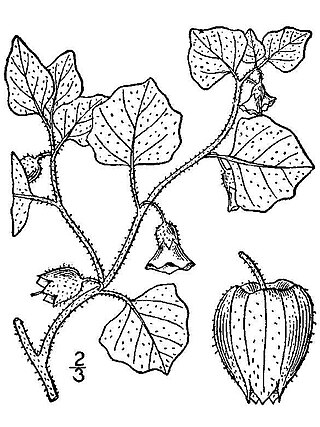
Physalis pubescens is a species of flowering plant in the nightshade family known by many common names, including husk tomato, low ground-cherry and hairy groundcherry in English, and muyaca and capulí in Spanish. It is native to the Americas, including the southern half of the United States, Mexico, Central and much of South America. It can be found elsewhere as an introduced species and sometimes a weed. It can grow in many types of habitat, including disturbed areas. This is an annual herb producing a glandular, densely hairy stem up to about 60 cm (24 in) in maximum height from a taproot. The oval or heart-shaped leaves are 3–9 cm (1.2–3.5 in) long and have smooth or toothed edges. The flowers blooming from the leaf axils are bell-shaped and about a centimeter long. They are yellow with five dark spots in the throats, and have five stamens tipped with blue anthers. The five-lobed calyx of sepals at the base of the flower enlarges as the fruit develops, becoming an inflated, ribbed, lanternlike structure 2–4 cm (0.79–1.57 in) long which contains the berry.

Physalis virginiana, the Virginia groundcherry, is a rhizomatous perennial with a deeply buried stem base. It is found mostly in eastern North America as far west as Wyoming.

Sagittaria australis, the Appalachian arrowhead or longbeak arrowhead, is a plant species native to much of the eastern part of the United States, from Louisiana to Iowa to New York State to Florida, mostly between New Jersey and Mississippi with scattered locations elsewhere in the range.

Physalis angustifolia, the coastal groundcherry, is a species of flowering plant in the nightshade family. It is native to the Gulf Coast shoreline of the Southeastern United States, where it is found on maritime dunes and sands.
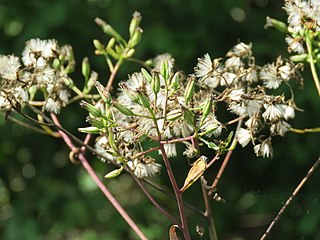
Arnoglossum ovatum, the ovateleaf cacalia, is a species of plant in the sunflower family. It is native to the southeastern and south-central United States from southern North Carolina to Florida and eastern Texas.

Bigelowia nuttallii is a species of North American flowering plants in the family Asteraceae, native to the southern United States.

Solidago latissimifolia, common name Elliott's goldenrod, is North American species of flowering plants in the family Asteraceae. It is native to the Atlantic Coast of the United States and Canada, from Nova Scotia south to Alabama and Florida.
Asclepias connivens is a species of milkweed, commonly called Baldwin's milkweed or the largeflower milkweed. It is an obligate wetland species, native to the southeastern United States.
Polygala boykinii, known by the common name Boykin's milkwort, is a species of flowering plant. It grows to about 2 feet high and produces a spear of white flowers. It is a dicot in the family Polygalaceae. It has been collected in Florida and Alabama.

Hypericum walteri, the greater marsh St. Johnswort or Walter's marsh St. John's Wort, is a flowering plant endemic to the eastern United States, from Texas to Delaware north to Illinois. It grows along waterbodies such as lakes and streams, in marshes, and in swamp forests.
Calliphysalis carpenteri, or Carpenter's groundcherry, is a perennial plant in the family Solanaceae, the "nightshade" plants. Native to sandy soils on the coastal plain regions of southeastern North America from northern Florida to Louisiana and Arkansas, it was first described from specimens collected in West Feliciana Parish, Louisiana. Its species name honors the botanical contributions of early Louisiana naturalist William Marbury Carpenter (1811-1848).

Alkekengi officinarum, the bladder cherry, Chinese lantern, Japanese-lantern, strawberry groundcherry, winter cherry, or Klabuster cherry is a species of flowering plant in the nightshade family Solanaceae. It is a close relative of the new world Calliphysalis carpenteri and a somewhat more distant relative to the members of the Physalis genus. This species is native to the regions covering Southern Europe to South Asia and Northeast Asia.

















